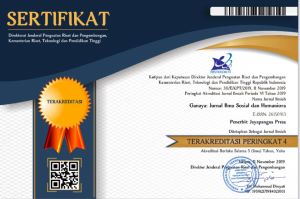The Effect of Cooperative Integrated Reading and Composition (CIRC) on Students’ Reading Comprehension Achievement
Keywords:
Effect, Reading Comprehension, CIRCAbstract
This study was intended to find out the effect of using Cooperative Integrated Reading and Composition on students reading comprehension. The population of this study was the students of Music Department English Department, Medan with three parallel classes, and there are (120) students totally. The sample of the research was two classes, which were selected by using cluster random sampling technique, the total were (80) students. The sample was divided into two groups; the first group is 40 students, (Grade X 1) which was the experimental group. The second group is 40 students, (Grade X 2) which was the control group. The experimental group was taught by using Cooperative Integrated Reading and Composition while control group was taught without using questioning strategy. The instrument used for collecting the data was test in the form of multiple choices with the total number of 20 questions. The tests were divided into two; pre-test and post-test. The reliability of the test was 0.9. After the data had been collected, they were analyzed by using t-test formula in order to see whether the discussion method significantly affects students reading comprehension. The result of the analysis showed that the t-observed (4.8), it was higher than the t-table (2.024) with the level of significant (0, 05) and the degree of freedom (df) (38). The result of the analysis showed that the hypothesis of the study was accepted. It was concluded that questioning strategy significantly affects students reading comprehension.References
Alderson, J. C. (2000). Assessing reading. Cambridge: Cambridge University Press.
Burns, C. P. et.al. (1984). Teaching Reading in Today’s Elementary Schools. 3rd. Ed. Boston: Houghton Mifflin Company.
Brassel, D. and Resinski, T. (2008). Comprehension that Work: Taking Students beyond Ordinary Understanding to Deep Comprehension. Hungtinton Beach: Shell Education.
Best, J. W., & Kahn, J. V. (2006). Research in Education (10th ed.). Boston: Pearson Education, Inc.
Day, R. R., & Park, J. (2005). Developing reading comprehension questions. Reading in a Foreign Language, 17(1), 60-73.
Damanik, A. S. and Herman. (2021). Improving Students’ Reading Comprehension Through Question Answer Relationship Strategy (QARS). Inovish Journal, Vol. 6, No. 1, PP. 84-101. DOI: https://doi.org/10.35314/inovish.v6i1.1949
Danielle, S. (2007). Reading Comprehension Strategies: Theories, Interventions, and Technologies. New Jersey: Lawrence Erlbaum Associates. Inc.
Grabe, W., and Stoller, F. L. (2002). Teaching and Researching Reading: Applied Linguistic in Action Series. Harlow: Pearson Education. Longman.
Herman, Sibarani, J. K., and Pardede, H. (2020). The Effect of Jigsaw Technique in Reading Comprehension on Recount Text. Cetta: Jurnal Ilmu Pendidikan, Jayapangus Press ISSN 2615-0891 (E) Vol. 3 No. 1 (2020), PP. 84-102. DOI: 10.37329/cetta.v3i1.413
Ivantara, E. P., Herman., and Manalu, D. B. (2020). The effect of using cooperative script on students’ reading comprehension at grade eleveth of SMA Negeri 2 Pematangsiantar . Acitya: Journal of Teaching & Education, Vol. 2 No. 2 2020, PP. 82-94. DOI: 10.30650/ajte.v2i2.1361
Klingner, J. K. & Vaughn, S. (1996). Reciprocal teaching of reading comprehension strategies for students with learning disabilities who use English as a second language. Elementary School Journal, 96, 275–293.
Lems, K. et al. (2010). Teaching Reading to English Language Learners Insights from Linguistic. New York: The Guilford Press
Lumbantobing, S. R. A. H., Pardede, H., and Herman. (2020). The Effect of Herringbone Technique on the Students’ Ability in Reading Comprehension on Recount Text . Journal of English Educational Study, Volume 3, Issue 2, November 2020, Page 1-10, E-ISSN: 2655-0776. DOI : 10.31932/jees.v3i2.656
Manullang, R. A., Sianipar, E., Herman, and Sinurat, B. (2022). The Application of Phonics Instruction in Reading Text at Grade X SMK N.1 Pematangsiantar. Periodica Journal of Modern Philosophy, Social Sciences and Humanities, 4, 25–31.
Rajagukguk, T. A., Herman. H., & Sihombing, P. S. R. (2020). The Effect of Using Collaborative Writing Method on Students’ ` Recount Text at Grade Ten of SMK YP 1 HKBP Pematangsiantar. Acitya: Journal of Teaching and Education, 2(2), 95-114. DOI: https://doi.org/10.30650/ajte.v2i2.1363
Silalahi, D. E., Herman, H., Sihombing, P. S. R., Damanik, A. S., and Purba, L. (2022). An Analysis of students’ achievement in reading comprehension through higher order thinking skills (HOTS). Al-Ishlah: Jurnal Pendidikan, 14(2), DOI: 10.35445/alishlah.v14i2.1249
Sinaga, Y. K., Herman, and Siahaan, P. L. (2020). The Effect of Partner Reading Strategy on Reading Comprehension. Journal of English Education and Teaching (JEET), Volume 4 number 2, June 2020, Page 206-218. DOI: 10.33369/jeet.4.2.206-218
Sirait, M. F., Hutauruk, B. S., & Herman. (2020). The Effect of Using Speed Reading Technique to the Students’ Ability in Comprehending a Text. Cetta: Jurnal Ilmu Pendidikan, 3(3), 485-498
Downloads
Published
How to Cite
Issue
Section
License

This work is licensed under a Creative Commons Attribution-ShareAlike 4.0 International License.
An author who publishes in the Cetta : Jurnal Ilmu Pendidikan agrees to the following terms:
- Author retains the copyright and grants the journal the right of first publication of the work simultaneously licensed under the Creative Commons Attribution-ShareAlike 4.0 License that allows others to share the work with an acknowledgement of the work's authorship and initial publication in this journal
- Author is able to enter into separate, additional contractual arrangements for the non-exclusive distribution of the journal's published version of the work (e.g., post it to an institutional repository or publish it in a book) with the acknowledgement of its initial publication in this journal.
- Author is permitted and encouraged to post his/her work online (e.g., in institutional repositories or on their website) prior to and during the submission process, as it can lead to productive exchanges, as well as earlier and greater citation of the published work (See The Effect of Open Access).
Read more about the Creative Commons Attribution-ShareAlike 4.0 Licence here: https://creativecommons.org/licenses/by-sa/4.0/.





